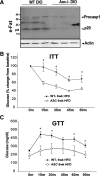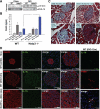Elimination of the NLRP3-ASC inflammasome protects against chronic obesity-induced pancreatic damage
- PMID: 21862613
- PMCID: PMC3199005
- DOI: 10.1210/en.2011-1326
Elimination of the NLRP3-ASC inflammasome protects against chronic obesity-induced pancreatic damage
Abstract
Clinical evidence that the blockade of IL-1β in type-2 diabetic patients improves glycemia is indicative of an autoinflammatory mechanism that may trigger adiposity-driven pancreatic damage. IL-1β is a key contributor to the obesity-induced inflammation and subsequent insulin resistance, pancreatic β-cell dysfunction, and the onset of type 2 diabetes. Our previous studies demonstrated that the ceramides activate the Nod-like receptor family, pyrin domain containing 3 (Nlrp3) inflammasome to cause the generation of mature IL-1β and ablation of the Nlrp3 inflammasome in diet-induced obesity improves insulin signaling. However, it remains unclear whether the posttranslational processing of active IL-1β in pancreas is regulated by the NLRP3 inflammasome or whether the alternate mechanisms play a dominant role in chronic obesity-induced pancreatic β-cell exhaustion. Here we show that loss of ASC, a critical adaptor required for the assembly of the NLRP3 and absent in melanoma 2 inflammasome substantially improves the insulin action. Surprisingly, despite lower insulin resistance in the chronically obese NLRP3 and ASC knockout mice, the insulin levels were substantially higher when the inflammasome pathway was eliminated. The obesity-induced increase in maturation of pancreatic IL-1β and pancreatic islet fibrosis was dependent on the NLRP3 inflammasome activation. Furthermore, elimination of NLRP3 inflammasome protected the pancreatic β-cells from cell death caused by long-term high-fat feeding during obesity with significant increase in the size of the islets of Langerhans. Collectively, this study provides direct in vivo evidence that activation of the NLRP3 inflammasome in diet-induced obesity is a critical trigger in causing pancreatic damage and is an important mechanism of progression toward type 2 diabetes.
Figures




Comment in
-
Inflammation as a sensor of metabolic stress in obesity and type 2 diabetes.Endocrinology. 2011 Nov;152(11):4005-6. doi: 10.1210/en.2011-1691. Endocrinology. 2011. PMID: 22021196 No abstract available.
Similar articles
-
The purinergic 2X7 receptor participates in renal inflammation and injury induced by high-fat diet: possible role of NLRP3 inflammasome activation.J Pathol. 2013 Nov;231(3):342-53. doi: 10.1002/path.4237. Epub 2013 Sep 3. J Pathol. 2013. PMID: 23843215
-
Vascular endothelial cells senescence is associated with NOD-like receptor family pyrin domain-containing 3 (NLRP3) inflammasome activation via reactive oxygen species (ROS)/thioredoxin-interacting protein (TXNIP) pathway.Int J Biochem Cell Biol. 2017 Mar;84:22-34. doi: 10.1016/j.biocel.2017.01.001. Epub 2017 Jan 4. Int J Biochem Cell Biol. 2017. PMID: 28064010
-
TLR9 and the NLRP3 inflammasome link acinar cell death with inflammation in acute pancreatitis.Gastroenterology. 2011 Jul;141(1):358-69. doi: 10.1053/j.gastro.2011.03.041. Epub 2011 Mar 24. Gastroenterology. 2011. PMID: 21439959 Free PMC article.
-
NLRP3 inflammasome: from a danger signal sensor to a regulatory node of oxidative stress and inflammatory diseases.Redox Biol. 2015;4:296-307. doi: 10.1016/j.redox.2015.01.008. Epub 2015 Jan 14. Redox Biol. 2015. PMID: 25625584 Free PMC article. Review.
-
Research progress on the NLRP3 inflammasome and its role in the central nervous system.Neurosci Bull. 2013 Dec;29(6):779-87. doi: 10.1007/s12264-013-1328-9. Epub 2013 Mar 20. Neurosci Bull. 2013. PMID: 23512739 Free PMC article. Review.
Cited by
-
Insulin resistance and liver histopathology in metabolically unhealthy subjects do not correlate with the hepatic abundance of NLRP3 inflammasome nor circulating IL-1β levels.BMJ Open Diabetes Res Care. 2021 May;9(1):e001975. doi: 10.1136/bmjdrc-2020-001975. BMJ Open Diabetes Res Care. 2021. PMID: 33941551 Free PMC article.
-
DPP-4 inhibition by linagliptin prevents cardiac dysfunction and inflammation by targeting the Nlrp3/ASC inflammasome.Basic Res Cardiol. 2019 Aug 6;114(5):35. doi: 10.1007/s00395-019-0743-0. Basic Res Cardiol. 2019. PMID: 31388770
-
Hydrogen Sulfide Attenuates High Glucose-Induced Human Retinal Pigment Epithelial Cell Inflammation by Inhibiting ROS Formation and NLRP3 Inflammasome Activation.Mediators Inflamm. 2019 Apr 24;2019:8908960. doi: 10.1155/2019/8908960. eCollection 2019. Mediators Inflamm. 2019. PMID: 31178664 Free PMC article.
-
Necroptosis increases with age in the brain and contributes to age-related neuroinflammation.Geroscience. 2021 Oct;43(5):2345-2361. doi: 10.1007/s11357-021-00448-5. Epub 2021 Sep 13. Geroscience. 2021. PMID: 34515928 Free PMC article.
-
Autophagy deficiency in myeloid cells increases susceptibility to obesity-induced diabetes and experimental colitis.Autophagy. 2016 Aug 2;12(8):1390-403. doi: 10.1080/15548627.2016.1184799. Epub 2016 Jun 23. Autophagy. 2016. PMID: 27337687 Free PMC article.
References
-
- Donath MY, Shoelson SE. 2011. Type 2 diabetes as an inflammatory disease. Nat Rev Immunol 11:8–107 - PubMed
-
- Dinarello CA, Donath MY, Mandrup-Poulsen T. 2010. Role of IL-1β in type 2 diabetes. Curr Opin Endocrinol Diabetes Obes 17:314–321 - PubMed
-
- Dominguez H, Storgaard H, Rask-Madsen C, Steffen Hermann T, Ihlemann N, Baunbjerg Nielsen D, Spohr C, Kober L, Vaag A, Torp-Pedersen C. 2005. Metabolic and vascular effects of tumor necrosis factor-α blockade with etanercept in obese patients with type 2 diabetes. J Vasc Res 42:517–525 - PubMed
Publication types
MeSH terms
Substances
Grants and funding
LinkOut - more resources
Full Text Sources
Other Literature Sources
Medical
Molecular Biology Databases
Miscellaneous

